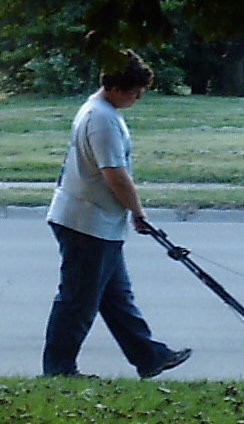HOW TO FEEL BETTER ABOUT AN ENORMOUS TO-DO LIST

The summer after my parents divorced, I was eight years old and my mom couldn’t afford childcare, so every morning before she left for work she would leave a five-dollar bill on the counter for my sister and me; when lunchtime rolled around we would walk two blocks down the road to a local fast food joint called Flavor Freeze.
The “Fried tenderloin and chocolate shake” special, while a steal for $2.49, is probably not something an 8-year-old should be chowing down on five days a week. But that’s what I did, daily, for an entire summer. 1995 was the year I became a fat kid.

(Image from the author)
According to science, my body mass index classification was ‘morbidly obese’. For several years to follow, I waddled from childhood into adolescence with disregard for self-control and enough self-loathing to fill a cement truck.
I remember once crying in a department store while school shopping one August afternoon because their pant sizing only went up to a 40-inch waist, which was too small. I was fifteen.
In tenth grade, stretch marks developed around my nipples. It felt like a “now or never” moment to take charge of my health. So I found a way to course-correct my habits: Control everything.
The more I controlled my food, activity, and sleep, the more weight I lost. What really worked, though, was to fill my time with activities in which I couldn’t eat. The busier I was, the less downtime I had to give in to temptation.
I became obsessed with being busy. I joined every club at school, and no hour in my schedule went unused. In a little over a year, I dropped 105 pounds.

Author image. Left image taken in 2001; right image taken in 2014.
My health journey continued for years after this, and this month marks 17 years strong of keeping the weight off.
What didn’t change at the time, however, was this yearning to fill my plate with things to do. I now associated busy-ness with liking myself and acceptance from others, and this construct evolved into its own slippery slope.
Your long to-do list is making you worse
“Do a brain dump, then get organized” was my general approach for managing life, and I eventually got used to both the optics of an oversized list of to-dos and making very little progress.
Many items never got done; some of them, like “Call a friend back,” spent so long on the back burner they birthed unfortunate consequences and the end of relationships.
After years of being a productivity snob, I now struggled to get things done. It was a strange fallacy: The more I did, the more there still seemed to be to do. It became normal to barely make a dent in my daily to-do list.
A problem emerges from this conditioning. Let’s say, for the sake of simple math, that you get 90 percent of your to-do list done. 90 percent eventually becomes your new baseline.
Over time, 90 percent becomes your new 100 percent. You perceive 90 percent as a success, as a job well done. I mean, it’s most of the way, right? You become calibrated to doing 90 percent of what you see in front of you.
The construct continues. So then you begin doing 90 percent of 90 percent, which is 81 percent. Over time, this becomes your new normal too. You look at a project, do 80-ish percent of it, and say to yourself “I’m maxed out.”
It becomes a vicious cycle. Strangely, you operate at a fraction of your potential but simultaneously convince yourself that this is your maximum capacity.
Reset the bar and hit 100%
I had to re-establish what it feels like to be 100% done — even if that meant taking my to-do list aspirations down several notches and refocusing on rigorous, complete progress.
My new normal was to limit each day to one to three tasks. Obviously, this simplification process didn’t make my workload go away, so I found I had to zoom out and visualize my whole week rather than take things day by day.
My sense of integrity began to change. I re-established that when I say something will happen, it happens. Giving my word became a mighty weapon for action.
I not only felt better but also got more of my deeper, more important projects done because busy-ness was no longer a distraction tactic.
Here are a few other best practices I honed that help me reframe my to-do list for success — some of them may help you too:
- Inventory your to-dos, then pick 1–3 “big goals”. In Brian Tracy’s book Focal Point, he offers a way to determine prioritization that always stuck with me: “If you were to unexpectedly go out of town tomorrow for a month, what’s the one thing that must be done today? If there’s time for one more thing, what is it?” Continue this one-by-one process to shape your priorities.
- Map your whole week. When your mind knows there will be a time and place for some of your other big projects or to-dos, you’ll be able to decompress, even if those time blocks are days away.
- Schedule your whitespace. It’s funny how whitespace works: The more whitespace I put in my calendar, the more focused and accomplished I feel throughout the week. If you’ve inventoried what you want to accomplish throughout the week, you no longer feel a constant daily crush to get everything off your plate.
I’m definitely still nowhere close to 100%. But once I identified that the systems I used to organize my life were built on self-flagellation tactics developed as a teenager, I was able to adjust and grow.
The workload is the same, but rather than feel a sense of doom and despair as I try to power through, I tap into success and peace as I navigate the week. My hope is that some of what has helped me organize my to-do list can help you too.

